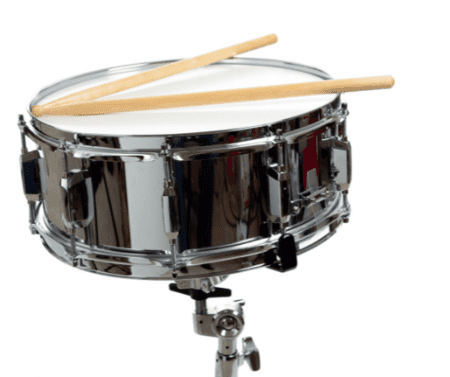Aspiring to greatness on the drums? Let Drum Coach show you how, with only 5 minutes of fun, daily practice. Watch your drumming transform swiftly!
Hey groovers! Today we’re diving deep into the rhythmic heart of your drum kit: the snare drum. If you’ve ever wondered how to get that perfect crack or rich depth from your snare, this blog post is your go-to guide. Here’s everything you need to know about how to tune your snare drum to achieve the ideal sound for your music style.
How Drum Tuning Works
Tuning drums is crucial for achieving a coherent and pleasing sound, whether you’re practicing at home or performing live. The process involves adjusting the tension of the drumheads and, for snares, the snare wires, to fine-tune the drum’s tone and response. Here’s a closer look at how various factors influence the tuning process:
- Diameter and Depth: The size of a drum affects its pitch and volume. Larger drums (in diameter) generally produce lower pitches, which is why your bass drum sounds much deeper than your snare. Depth also plays a role; deeper drums can offer more volume and sustain, which is great for live performances where power is needed.
- Number of lugs: Lugs are the points where the drumhead is attached to the shell, and their number can vary. More lugs on a drum allow for a more even distribution of tension, which can help achieve a cleaner, more consistent sound. Snares typically have more lugs than toms to support a tighter, more precise tension necessary for their characteristic sharp, crisp sounds.
- Shell material: The material of the drum shell also influences the sound. Common materials include wood (like maple, birch, and mahogany), which provides a warm tone, and metal (such as brass or steel), known for a brighter, more cutting sound. The choice of material can depend on the music style you play; for example, jazz drummers might prefer the mellower tones of a maple shell, whereas rock drummers may opt for the punch of steel.
Get your drumming to the next level in just 10 days 🚀
Find your perfect practice routine with Drum Coach with exercises tailored for all levels. With Drum Coach you get:
- Drums lessons crafted by Mariano Steimberg, professional drummer, and professor at Berklee College of Music.
- Unlock over 500 drum exercises and rudiments
- Start Free with the Drumming Essentials course. No fancy gear needed!

If you are looking for your perfect drumming kit, you can check out our tips to find the best one for you: Drum Set Guide for beginners. How to find your perfect kit?
Characteristics of the Snare Drum
The snare drum is known for its sharp, crisp sound that stands out in any drumbeat. It serves as the rhythmic cornerstone in most music genres, from rock to jazz. This distinct sound is achieved by its metal wires (the snares) that stretch across the bottom head, vibrating against it when the top head is struck.

Remember to tune the top and bottom snare head, take advantage of our 3 step process.
Tuning the Bottom Snare Head
- Start Detached: Begin with the bottom head (snare side). Ensure the snares are disengaged (loose or off) to avoid interference while tuning.
- Even Tension: Using a drum key, tighten each rod finger-tight. Then, incrementally tighten each lug in a star pattern to maintain even tension across the head.
- Check the Pitch: Tap near each lug with a drumstick and listen for uniform pitch. The bottom head should be tight enough to resonate clearly but not so tight as to choke the sound.
Tuning the Top Snare Head
- Initial Tightening: Similar to the bottom head, tighten each lug finger-tight.
- Tuning for Tone: Here’s where personal preference and style come into play. For rock, you might want a deeper tone, requiring a slightly looser tension. For classical and jazz, a tighter, crisper sound is often preferred.
- Fine-Tuning: Again, use a star pattern to adjust each lug, ensuring the pitch is even around the drum.
Want to rock drum rudiments? Join the Drumming Essentials course in Drum Coach app! With just 5 minutes daily, elevate your skills in 10 days. Fun, easy, and effective. 🚀✨
Tailoring Snare Drum Tuning to Musical Styles
When it comes to drum tuning, one size definitely does not fit all. The tuning strategy you choose can dramatically alter the character and feel of your music. Here’s how to adapt your snare drum tuning to different musical contexts, with a focus on rock and jazz—two genres with distinctly different demands.
Find out what to take into account when tunning snare drums for rock or jazz music

Rock Music: Deep and Resonant
For rock music, the snare drum sound is often deep, thick, and somewhat lower in pitch. This powerful sound complements the strong bass lines and distorted guitars typical of the genre. Here’s how to achieve that:
- Looser Top Head: Tune the top head of your snare drum slightly looser than you would for jazz. This looser tuning allows the drum to produce a lower, beefier tone that resonates with the gritty essence of rock. It’s about getting a sound that feels as raw and powerful as the music.
- Thicker Drumheads: Using thicker or double-ply drumheads can help achieve a deeper sound. These heads not only lower the pitch but also reduce overtones and provide a more focused attack, which is ideal for the punchy, driving beats of rock.
- Tuning the Bottom Head: While the top head might be looser, the bottom head should still be relatively tight to ensure the snares respond crisply. This helps maintain clarity and articulation, so the snare cuts through the dense mix of rock instrumentation.
You may also find interesting:
Jazz Music: Tight and Responsive
Jazz drumming requires a snare sound that’s tighter and more responsive, reflecting the genre’s nuanced and intricate playing styles. Jazz drummers often utilize a range of dynamics and subtle touches, so the snare drum needs to be highly sensitive to light strokes.
- Tighter Tuning: For jazz, both the top and bottom heads are tuned tighter compared to rock. This higher tension allows for a crisper, cleaner sound with more bounce, which is crucial for the brush strokes and lighter stick hits common in jazz playing.
- Thinner Drumheads: Single-ply drumheads are often preferred in jazz for their brighter tone and higher sensitivity. These heads facilitate the dynamic range and subtleties of jazz drumming, from soft ghost notes to accentuated rim shots.
- Snare Wire Adjustment: The tension on the snare wires should also be finely adjusted to increase sensitivity. Tighter wires enhance the snare’s responsiveness to softer dynamics, which is key for the complex rhythms and lighter touch of jazz drumming.
Dream of drumming like a pro?
Start free with our Drumming Essentials course. Go to your AppStore, download the Drum Coach app to get:
🥁 5 minutes of fun, daily exercises.
🎵 A beginner-friendly approach to improve steadily.
💡 Engaging lessons that make learning easy and effective.
Enhancing Snare Drum Sound Beyond Tuning
Beyond just tuning, there are several additional modifications you can employ to further shape the sound of your snare drum to suit your musical needs. Here’s how you can use various drum accessories and techniques to refine your snare’s tone:
Muffling Techniques
One common challenge with snare drums is managing overtones and unwanted ring. Muffling can help control these and achieve a cleaner sound:
- Moongel or Drum Dots: These gel pads can be placed on the drumhead to subtly dampen overtones, reducing ring and controlling sustain. They’re especially useful in studio settings where precise sound control is needed.
- Drum Tape: Similar to Moongel, drummers often use strips of gaffer tape as a more permanent solution to dampen overtones. Tape can be more customizable as you can adjust the amount and configuration to suit your sound needs.
- Internal Muffling: Some snare drums come with built-in muffling mechanisms, such as felt strips or adjustable internal dampers. These can be tightened against the drumhead to reduce sustain and achieve a drier sound.
Snare Wire Adjustments
The snare wires are crucial for the drum’s characteristic sound, and adjusting their tension can dramatically alter the snare’s tone:
- Tighter Wires: Increasing the tension of the snare wires makes the drum more responsive to light strokes, producing a sharper, crisper sound. This is ideal for styles requiring high articulation, like jazz or concert snare drumming.
- Looser Wires: Decreasing the tension can yield a fatter, more guttural sound that’s great for rock or heavy pop. This setting allows for a greater presence of the drum’s fundamental tone with less interference from the wires.
Alternative Drumheads
Switching out the drumhead is another effective way to change the drum’s sound:
- Coated Heads: These provide a warmer tone and more controlled sustain compared to clear heads. They’re excellent for general use and particularly favored in live jazz performances for their subtle articulation.
- Double-ply Heads: These heads are thicker and offer more durability and a deeper sound. They’re great for heavier playing styles like rock and metal, where robust and punchy tones are needed.
Additional Accessories
Drummers often employ various accessories to tweak their snare sound further:
- Rings and O-rings: These are circular rings placed on the drumhead to dampen overtones and shorten decay. They’re perfect for achieving a focused, tight sound during live performances.
- Brushes and Different Sticks: Switching from standard drumsticks to brushes or rods can significantly modify the playing feel and resultant sound. Brushes yield a smoother, more sweeping sound, suitable for ballads and soft jazz, while rods offer a compromise between the softness of brushes and the attack of sticks.
Closing thoughts
By exploring these modifications, you can tailor your snare drum to perfectly suit any musical setting, ensuring it complements the style and atmosphere of each performance. Remember, the snare drum often sets the tone for the entire kit, so these adjustments can be crucial in defining your overall sound. Keep experimenting and find the combinations that bring out the best in your beats!
Get your drumming to the next level in just 10 days 🚀
Find your perfect practice routine with Drum Coach with exercises tailored for all levels. With Drum Coach you get:
- Drums lessons crafted by Mariano Steimberg, professional drummer, and professor at Berklee College of Music.
- Unlock over 500 drum exercises and rudiments
- Start Free with the Drumming Essentials course. No fancy gear needed!

Get ready to take your drumming to the next level. Get expert tips on coordination, drumming techniques, improvisation and more in the post titled “Charting Your Drumming Journey”. / Written by: Raul Rodrigues: CEO of Drumap, Drummer, Music School Director and Mariano Steimberg: Drum Professor at Berklee College of Music, Valencia Campus.










